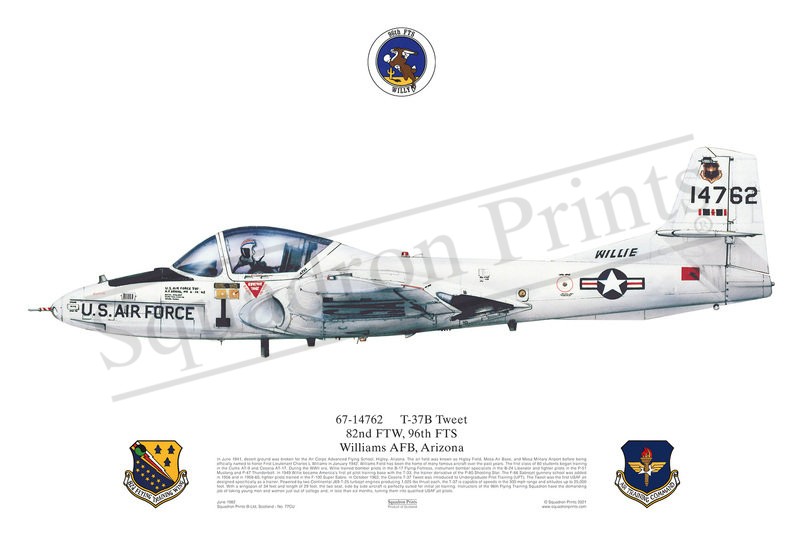#77CU T-37B Tweet, 96 FTS, Squadron Print

Description
Squadron Prints Lithograph No. 77CU - 67-14762, T-37B Tweet, 96 FTS, 82nd FTW, Williams AFB, Arizona.
In June 1941, desert ground was broken for the Air Corps Advanced Flying School, Higley, Arizona. The air field was known as Higley Field, Mesa Air Base, and Mesa Military Airport before being officially named to honor First Lieutenant Charles L Williams in January 1942. Williams Field has been the home of many famous aircraft over the past years. The first class of 80 students began training in the Curtis AT-9 and Cessna AT-17. During the WWII era, Willie trained bomber pilots in the B-17 Flying Fortress, instrument bomber specialists in the B-24 Liberator and fighter pilots in the P-51 Mustang and P-47 Thunderbolt. In 1949 Willie became America’s first jet pilot training base with the T-33, the trainer derivative of the P-80 Shooting Star. The F-86 Sabrejet gunnery school was added in 1956 and in 1958-60, fighter pilots trained in the F-100 Super Sabre. In October 1962, the Cessna T-37 Tweet was introduced to Undergraduate Pilot Training (UPT). The Tweet was the first USAF jet designed specifically as a trainer. Powered by two Continental J69-T-25 turbojet engines producing 1,025 lbs thrust each, the T-37 is capable of speeds in the 300 mph range and altitudes up to 25,000 feet. With a wingspan of 34 feet and length of 29 feet, the two seat, side by side aircraft is perfectly suited for initial jet training. Instructors of the 96th Flying Training Squadron have the demanding job of taking young men and women just out of college and, in less than six months, turning them into qualified USAF jet pilots.
You may also like
-
SALE RIAT 2018 Print Juno, Phenom, Sentinel, Atlas, F-35 Lightning
ZJ692; ZM334; ZM505; ZM416; ZM148RIAT 2018RAF Fairford -
Royal Saudi Air Force Typhoon print
313; 1005; 802410 Sqn; 80 Sqn; 3 SqnTaif, King Fahad AB
